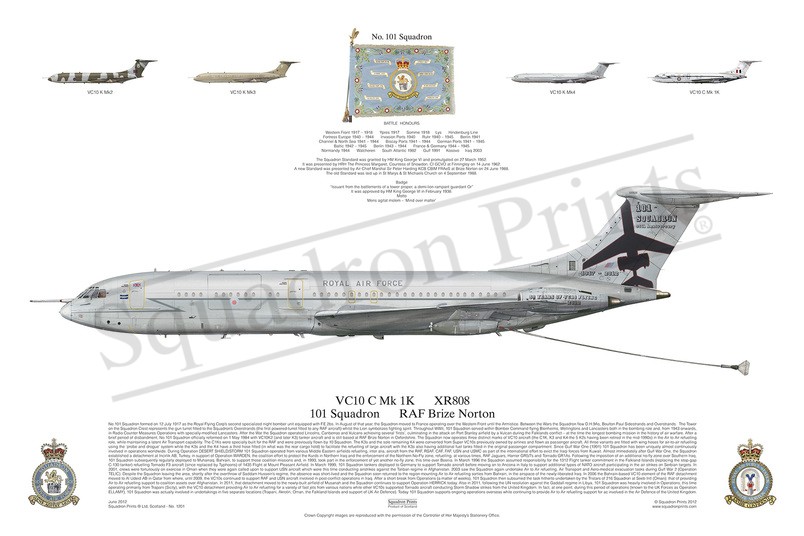#1201CU VC10 C1K, special tail

Purchased products will not feature the Squadron Prints watermark
Description
Squadron Prints Lithograph No. 1201CU - VC10 C Mk 1K, XR808, 101 Squadron, RAF Brize Norton, 50 Years of VC10 Flying.
No.101 Squadron formed on 12 July 1917 as the Royal Flying Corp\'s second specialized night bomber unit equipped with F.E.2bs. In August of that year, the Squadron moved to France operating over the Western Front until the Armistice. Between the Wars the Squadron flew D.H.9As, Boulton Paul Sidestrands and Overstrands. The Tower on the Squadron Crest represents the gun turret fitted to the Squadron\'s Overstrands (the first powered-turret fitted to any RAF aircraft) whilst the Lion symbolizes fighting spirit. Throughout WWII, 101 Squadron served within Bomber Command flying Blenheims, Wellingtons and Lancasters both in the bombing role and, from 1943 onwards, in Radio Counter Measures Operations with specially-modified Lancasters. After the War the Squadron operated Lincolns, Canberras and Vulcans achieving several \'firsts\', culminating in the attack on Port Stanley airfield by a Vulcan during the Falklands conflict - at the time the longest bombing mission in the history of air warfare. After a brief period of disbandment, No.101 Squadron officially reformed on 1 May 1984 with VC10K2 (and later K3) tanker aircraft and is still based at RAF Brize Norton in Oxfordshire. The Squadron now operates three distinct marks of VC10 aircraft (the C1K, K3 and K4-the 5 K2s having been retired in the mid-1990s) in the Air to Air refuelling role, while maintaining a latent Air Transport capability. The C1Ks were specially built for the RAF and were previously flown by 10 Squadron. The K3s and the sole remaining K4 were converted from Super VC10s previously owned by airlines and flown as passenger aircraft. All three variants are fitted with wing hoses for air-to-air refuelling using the \'probe and drogue\' system while the K3s and the K4 have a third hose fitted (in what was the rear cargo hold) to facilitate the refuelling of large aircraft with the K3s also having additional fuel tanks fitted in the original passenger compartment. Since Gulf War One (1991) 101 Squadron has been uniquely almost continuously involved in operations worldwide. During Operation DESERT SHIELD/STORM 101 Squadron operated from various Middle Eastern airfields refuelling, inter alia, aircraft from the RAF, RSAF, CAF, FAF, USN and USMC as part of the international effort to evict the Iraqi forces from Kuwait. Almost immediately after Gulf War One, the Squadron established a detachment at Incirlik AB, Turkey, in support of Operation WARDEN, the coalition effort to protect the Kurds in Northern Iraq and the enforcement of the Northern No-Fly zone, refuelling, at various times, RAF Jaguars, Harrier GR5/7s and Tornado GR1As. Following the imposition of an additional no-fly zone over Southern Iraq, 101 Squadron subsequently regularly deployed to Muharraq, Bahrain, to support those coalition missions and, in 1993, took part in the enforcement of yet another no-fly zone, this time over Bosnia. In March 1996 the Squadron assumed responsibility for the 1312 Flight tanker commitment in the Falkland Islands (replacing the stop-gap C-130 tanker) refuelling Tornado F3 aircraft (since replaced by Typhoons) of 1435 Flight at Mount Pleasant Airfield. In March 1999, 101 Squadron tankers deployed to Germany to support Tornado aircraft before moving on to Ancona in Italy to support additional types of NATO aircraft participating in the air strikes on Serbian targets. In 2001, crews were fortuitously on exercise in Oman when they were again called upon to support USN aircraft which were this time conducting airstrikes against the Taliban regime in Afghanistan. 2003 saw the Squadron again undertake Air to Air refuelling, Air Transport and Aero-medical evacuation tasks during Gulf War 2 (Operation TELIC). Despite the Squadron leaving the area, shortly after the overthrow of Saddam Hussein\'s regime, the absence was short-lived and the Squadron soon returned to the region mounting Air to Air refuelling sorties from Bahrain, in the airspace of the newly-liberated Iraq. In 2006 the Bahrain-based VC10 element of the RAF detachment moved to Al Udeid AB in Qatar from where, until 2009, the VC10s continued to support RAF and USN aircraft involved in post-conflict operations in Iraq. After a short break from Operations (a matter of weeks), 101 Squadron then subsumed the task hitherto undertaken by the Tristars of 216 Squadron at Seeb Intl (Oman); that of providing Air to Air refuelling support to coalition assets over Afghanistan. In 2011, that detachment moved to the newly-built airfield of Musanah and the Squadron continues to support Operation HERRICK today. Also in 2011, following the UN resolution against the Gaddafi regime in Libya, 101 Squadron was heavily involved in Operations, this time operating primarily from Trapani (Sicily), with the VC10 detachment providing Air to Air refuelling for a variety of fast jets from various nations while other VC10s supported Tornado aircraft conducting Storm Shadow strikes from the United Kingdom. In fact, at one point, during this period of operations (known to the UK Forces as Operation ELLAMY), 101 Squadron was actually involved in undertakings in five separate locations (Trapani, Akrotiri, Oman, the Falkland Islands and support of UK Air Defence). Today 101 Squadron supports ongoing operations overseas while continuing to provide Air to Air refuelling support for ac involved in the Air Defence of the United Kingdom.
You may also like
-
SALE F-16AM Fighting Falcon Signed Display Print
J-879312 SqnVolkel Air Base, The Netherlands
